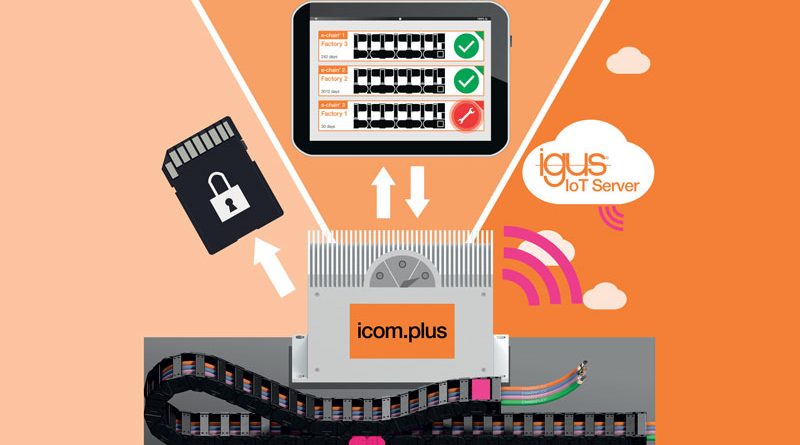How to Integrate the Data Acquired by Sensors
icom.plus, the advanced version of igus communication module, enables predictive maintenance with flexible data integration for high IT security.
by Andrea Baty
Being able to predict and plan maintenance is the goal pursued by igus with its smart plastics solutions. Intelligent sensors, for example, measure the wear of energy chains, slewing rings and linear guides. With the new communication module icom.plus, the customer can now decide in which form they would like to incorporate the acquired data from the sensors. From an offline version for restrictive environments up to the connection of the values to the igus server for automatic spare parts ordering, the user is free to integrate and read their data.
Data are transmitted to an intelligent system to be interpreted
Under the name isense, igus carries sensors of various kinds that detect the condition of igus components such as cables or energy chains. They measure among other things the wear during the operation and alert the user early enough to plan repair or replacement. By networking with the icom communication module, the data is transmitted to an intelligent system. The module can be connected to all igus specific sensors. For example, with sensors for the measurement of abrasion, or the wear measurement of the pin-bore connection of the energy chain, as well as sensors for the detection of break and push-pull forces and for cable monitoring. Once the measured values from a sensor have been transferred to the icom module, they have to be “interpreted”, i.e. understood in order to generate instructions from the same. So far, this has been possible via the connection to the igus cloud. Due to the increasing importance of IT security, however, many companies are increasingly relying on the development of their own SCADA systems, which is why igus has now advanced its data concentrator into icom.plus. With the new module, the customer can integrate the data in the way that best suits their equipment.
Flexible data connection through new 3-in-1 module
The icom.plus is programmed via igus online configurations with initial service life algorithms. The special feature: the new communication module can be operated offline upon customer request, after online installation without update function. In this “semi-offline” case, during an initial “learning phase”, the device requires a temporary, short-term secured IoT access to the igus server to match the calculation algorithms to the actual motion and environmental profile of the customer application. In very restrictive areas, the update can also be performed from the beginning via a storage medium completely offline. In this way, the user can flexibly design the connection of the module and their data and establish a balance between maximising the runtime and IT security. The motion profile required for the calculation of the maintenance recommendation is read directly from the control system via the bus system of the machine. In the same way, the information about the number of days until the next recommended maintenance and freely definable warning messages about unusual changes in the sensor data are transferred to the PLC control. The user information is provided directly via the system monitor or via customer-specific SCADA systems.
Predictive maintenance by connecting to the company’s server
With the online connection of the icom.plus, a continuous matching of the service life statement with the igus cloud takes place in order to enable maximum system runtimes with minimal failure risk. The data in the cloud draws on the 10 billion test cycles of energy chains and cables performed in the company’s own 2,750 square metre test laboratory, and thanks to machine learning and AI, igus can provide precise information on the durability of the solutions used and inform the user about a necessary replacement beforehand.

